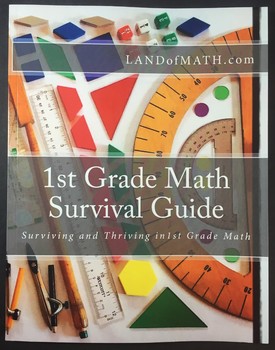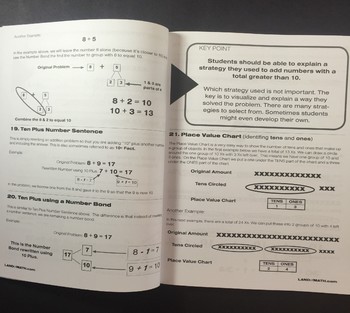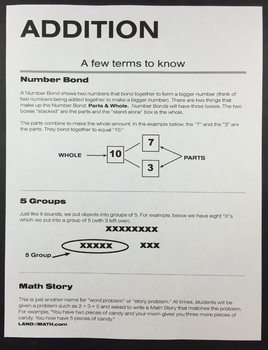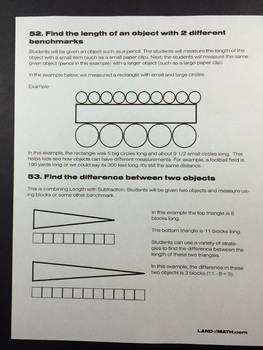1st Grade Math Survival Guide
Description
A couple of years ago my daughter was in 1st grade. Her school was using Eureka Math (aka Engage New York). When I would sit down to help with her math assignments I encountered a variety of unfamiliar terms (Arrow Notation, Number Bonds, Tape Diagrams etc.).
The "1st Grade Math Survival Guide" explains and organizes all the key concepts for students in first grade. It's geared for parents, but is an excellent resource for teachers as well.
Below is an outline of the topics covered in this Guide.
OUTLINE OF TOPICS
ADDITION
1. Whole Amounts can be broken into two parts
2. Match different addition models
3. Using a Number Bond to make a Number Sentence
4. Using a Number Sentence to make a Number Bond
5. Make multiple Number Bonds or Number Sentences from a given number
6. Write 2 Expressions from a given Number Bond
7. If given a math story, expression, number bond or math picture, you can make any of the other 3.
8. Find the missing part when adding.
9. The Count On Strategy to find the missing part
10. The Count Back Strategy to find a missing part
11. Arrow Notation Way (aka Arrow Way Notation)
12. Adding Double Facts 13. Adding Double Facts + 1
14. Writing Equal Expressions (aka number sentence)
15. Make 10 Strategy
16. Adding 3 numbers using the Make 10 Strategy
17. Using 10 Frames to Add
18. Make 10 Strategy using Number Bonds
19. Ten Plus Number Sentence
20. Ten Plus using a Number Bond
21. Place Value Chart (identifing Tens and Ones)
22. Hide Zero Picture
23. Adding by putting in Groups of Ten
24. Say Ten Way vs. Regular Way
25. Group 10 Adding (Matching)
26. Quick Tens
27. Adding with Quick Tens
28. Adding 10 to Multiples of 10 (up to 100)
29. Adding a 2 digit & a 1 digit number •When the ones added are equal to or greater than 10
30. Using simple single digit problems to help solve other problems.
31. Adding a pair of 2 digit numbers •When the ones added are less than 10
32. Adding a pair of 2 digit numbers •When the ones added are equal or greater than 10
SUBTRACTION
33. Subtraction is taking a part away from the whole amount
34. Subtraction using drawing to model
35. Given a Drawing, Number Story, Subtraction Sentence or Number Bond you can create or match to the others.
36. Finding the Missing Part When Adding
37. Using a drawing to find the missing Part When Adding
38. Matching the Addition Sentence with the Subtraction Sentence
39. Make 10 subtract from 10 (aka Take from 10) - Subtracting a single digit from a ten
40. Take from 10 (aka Make 10 subtract from 10) and the Count On strategy together 41. Subtracting 10 from Multiples of 10 - Taking 10 away from any number ending in zero up to 100
COMPARING
42. Compare two single digit amounts
43. Compare 2 Quantities (amounts) using a Place Value Chart (double digits)
44. Compare 2 Quantities (amounts) using Quick Tens
45. Compare Money (amounts) using Dimes and Pennies
46. Compare and Order Numbers
LENGTH
47. Using a benchmark to compare the length of objects
48. Organizing Objects
49. Compare the lengths of 3 objects using spaces
50. Compare the lengths of 3 objects using blocks
51. Estimate the Length of objects or distance
52. Find the length of an object with 2 different benchmarks
53. Find the difference between two objects
GEOMETRY
54. Recognizing Two Dimensional Shapes
55. Recognizing Three Dimensional Shapes
56. Composite Shapes
57. Recognizing Halves and Quarters
ORGANIZE DATA
58. Using Tally marks
59. Reading Tally marks
60. Comparing Tally marks
61. Collecting, sorting, organizing and answering questions
62. Make a table/graph with blocks
TIME
63. Recognizing Time on the Hour
64. Recognizing Time Half Past the Hour
MONEY
65. Identifying Pennies, Nickles, Dimes & Quarters
66. Adding and Subtracting Money
67. Find the value of a collection of coins
TAPE DIAGRAM
- A basic explanation





